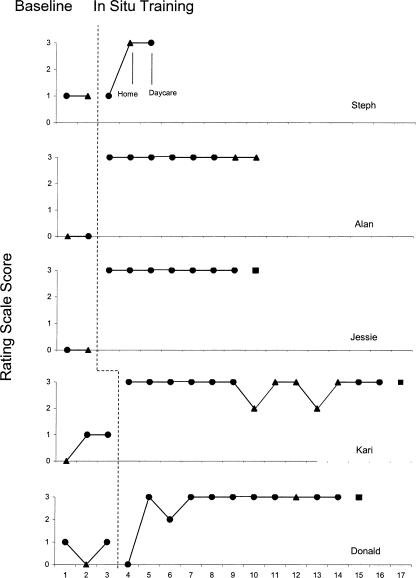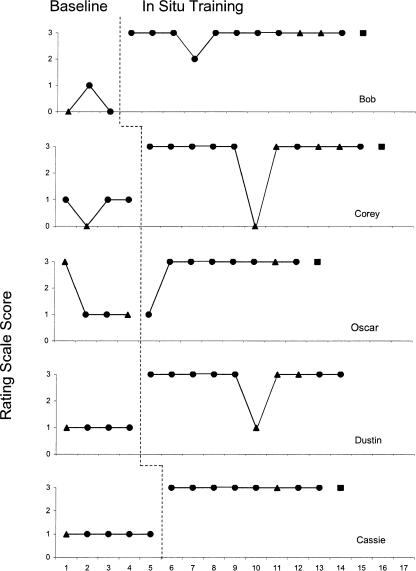Abstract
This study evaluated behavioral skills training with added in situ training for teaching safety skills to prevent gun play. Following baseline, each child received two sessions of behavioral skills training and one in situ training session. Additional in situ training sessions were conducted until the child exhibited the safety skills (don't touch the gun, get away, and tell an adult). All children acquired and maintained the safety skills at a 3-month follow-up. In addition, of the 7 children assessed in a dyad situation, all exhibited the correct skills in the presence of another child.
Keywords: safety skills, behavioral skills training, in situ training, children, firearm injury protection
Hundreds of children in the United States are injured or killed each year by firearms as a result of unintentional shootings (Eber, Annest, Mercy, & Ryan, 2004). Two important risk factors associated with unintentional firearm injuries in children are unsafe firearm storage and children's tendency to play with guns they find. Recently, researchers have evaluated procedures to prevent gun play (e.g., Gatheridge et al., 2004; Himle, Miltenberger, Gatheridge, & Flessner, 2004). Himle, Miltenberger, Flessner, and Gatheridge (2004) and Miltenberger et al. (2004) showed that behavioral skills training (BST) was effective for some children, but that the effectiveness of BST was enhanced with the addition of in situ training for others. It is not clear whether BST would be more effective if in situ training were added earlier in the training process. The purpose of the present study was to evaluate BST combined with in situ training for teaching safety skills to 4- and 5-year-olds to prevent gun play.
METHOD
Participants and Settings
Ten children (7 boys and 3 girls), ages 4 and 5 years old, were recruited from local preschool programs. Training and assessment sessions took place in the participant's classroom or at his or her home.
Target Behaviors, Data Collection, and Interobserver Agreement
The three safety skills needed when finding a gun were scored on a 3-point scale as follows: 0 = touches the gun, 1 = doesn't touch the gun, 2 = doesn't touch the gun and leaves the area (within 10 s of finding the gun), and 3 = doesn't touch the gun, leaves the area, and tells an adult (teacher or parent) about finding the gun.
Data were collected on target behaviors during in situ assessments in which a gun was placed in a location at school or home where the child would find it. The child's behavior was observed via a hidden videocamera without his or her awareness. Four different guns (disabled handguns provided by the local police department) were used. After the handgun was placed in the designated location, a teacher or parent asked the child to go to the location for a particular reason (e.g., “I left a snack on the kitchen table for you”). During the assessments, a researcher was always present but out of sight to function as a reliability observer and to implement in situ training when needed.
A second observer independently scored 33% of the assessments. Agreements were scored for each of the three target behaviors by dividing agreements by agreements plus disagreements and multiplying by 100%. There was 100% agreement across participants and phases.
Procedure
BST with in situ training was implemented in a multiple baseline across participants design. Three months after training, follow-up assessments were conducted. In addition, dyad assessments were conducted for 7 of the participants.
Baseline
In situ assessments occurred in the school and home environments. Participants did not receive any feedback on their performance in baseline.
In situ training. Each participant received two BST sessions consisting of instructions, modeling, rehearsal, and feedback as described by Himle, Miltenberger, Flessner, and Gatheridge (2004). First, the trainer explained the danger associated with firearms and told the child that when finding a gun the child should not touch it, get away from the gun, and tell an adult about finding the gun. Second, the trainer modeled the safety behaviors using a disabled handgun. Next, the trainer described a scenario and had the child rehearse the safety skills. The trainer provided praise for correct responses and corrective feedback as needed. In each training session, the child practiced the safety skills with praise or corrective feedback until he or she executed the skills correctly in five consecutive role plays.
Within 30 min after the second training session, the child's teacher arranged a situation in which the child found a gun without the knowledge that he or she was being observed. If the child did not execute the safety skills, the trainer entered the room and provided in situ training. After entering the room, the trainer asked the child what he or she should have done when finding the gun. After describing the correct behaviors to the trainer, the child rehearsed the correct behavior five times. An in situ assessment was then conducted within 2 days, and if the child exhibited the correct behavior, the teacher thanked the child for reporting the gun. If the child did not engage in the correct behavior, additional in situ training sessions were conducted until the child scored a 3 on three or more consecutive in situ assessments.
Follow-up And Dyad Assessment
Three months after the end of training, a follow-up assessment was conducted (except for Steph, who moved away before completing the study). Within 2 weeks after the 3-month follow-up assessment, a dyad assessment was conducted for 7 of the remaining 9 participants. In the dyad assessment, 2 participants were randomly paired. A teacher sent them out to the playground (with no other children present) to do a task together. Once on the playground, the children found a gun that was placed there just before their arrival. A researcher, unseen by the children, observed from behind a fence.
Results And Discussion
The results are shown in Figures 1 and 2. In baseline at school and home, all children touched the gun or did nothing when they found the gun (except for the first assessment for Oscar, who exhibited all three safety skills). All 10 children executed the safety skills following BST with in situ training in school and home assessments. Furthermore, all children executed the skills correctly at the 3-month follow-up and during the dyad assessment. Seven children executed the skills following one in situ training session. Two children (Steph and Oscar) needed two in situ training sessions, and 1 child (Donald) needed four in situ training sessions before they executed the skills consistently.
Figure 1. Rating scale scores for 5 participants during baseline and in situ training phases.
Circles are day-care assessments, triangles are home assessments, and squares are dyad assessments. The last home or day-care data point for all participants except Steph is a 3-month follow-up assessment.
Figure 2. Rating scale scores for 5 participants during baseline and in situ training phases.
Circles are day-care assessments, triangles are home assessments, and squares are dyad assessments. The last home or day-care data point for all participants is a 3-month follow-up assessment.
Although all of the children learned the skills with in situ training, 3 children (Kari, Corey, and Dustin) failed to execute the skills during their first home assessment after training, suggesting that the skills did not generalize to the home setting. However, with one additional in situ training session (two for Kari), the skills did generalize to the home.
One limitation of the current study is that we did not directly compare BST with and without in situ training. However, the results of this study demonstrate that BST with in situ training is more efficient and effective than BST alone as evaluated by Himle, Miltenberger, Flessner, and Gatheridge (2004) and Miltenberger et al. (2004). In the current study, all children demonstrated the skills following BST with in situ training, most after just two BST sessions and one in situ training session.
It is not clear why in situ training in this study was more effective than BST as evaluated in previous investigations. One explanation is that in situ training amounted to reinforcing instances of generalization because the participants received praise for exhibiting the skills in the same context in which assessments took place. Another possible reason is that getting caught with the gun during an in situ training trial is aversive (because children have a history of punishment in situations in which they are caught doing something they should not do), and the use of the skills in subsequent assessments is negatively reinforced through avoidance of getting caught with the gun again.
This investigation was the first to show that, following training, children used the safety skills when they found a gun in the presence of a peer. Future research should evaluate participants' safety skills in the presence of an untrained peer and in the presence of confederates who provide various challenges (e.g., daring the participant to touch the gun, etc.).
Although BST with in situ training resulted in immediate skill acquisition in the current study, the utility of in situ training for training large numbers of children may be limited. Future research needs to evaluate the utility of in situ training or other generalization strategies so that the procedure may be more widely adopted and used to train as many children as possible. In addition, future research should evaluate strategies to promote safe storage practices so that firearms are no longer accessible to children. If the safety threat were removed, there would no longer be a need for children to learn these safety skills.
References
- Eber G.B, Annest J.L, Mercy J.A, Ryan G.W. Nonfatal and fatal firearm-related injuries among children aged 14 years and younger: United States, 1993–2000. Pediatrics. 2004;113:1686–1692. doi: 10.1542/peds.113.6.1686. [DOI] [PubMed] [Google Scholar]
- Gatheridge B.J, Miltenberger R, Huneke D.F, Satterlund M.J, Mattern A.R, Johnson B.M, et al. A comparison of two programs to teach firearm injury prevention skills to 6 and 7 year old children. Pediatrics. 2004;114:e294–e299. doi: 10.1542/peds.2003-0635-L. [DOI] [PubMed] [Google Scholar]
- Himle M.B, Miltenberger R.G, Flessner C, Gatheridge B. Teaching safety skills to children to prevent gun play. Journal of Applied Behavior Analysis. 2004;37:1–9. doi: 10.1901/jaba.2004.37-1. [DOI] [PMC free article] [PubMed] [Google Scholar]
- Himle M, Miltenberger R, Gatheridge B, Flessner C. An evaluation of two procedures for training skills to prevent gun play in children. Pediatrics. 2004;113:70–77. doi: 10.1542/peds.113.1.70. [DOI] [PubMed] [Google Scholar]
- Miltenberger R.G, Flessner C.A, Gatheridge B.J, Johnson B.M, Satterlund M.J, Egemo K. Evaluation of behavioral skills training to prevent gun play in children. Journal of Applied Behavior Analysis. 2004;37:513–516. doi: 10.1901/jaba.2004.37-513. [DOI] [PMC free article] [PubMed] [Google Scholar]




